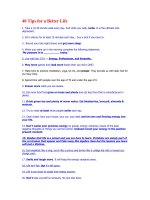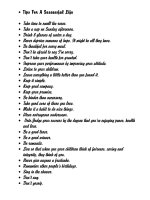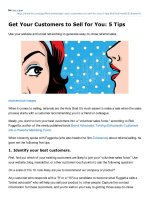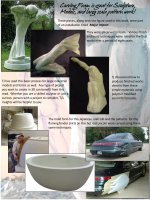5 Tips for Creating a Team Building Culture at Work pdf
Bạn đang xem bản rút gọn của tài liệu. Xem và tải ngay bản đầy đủ của tài liệu tại đây (403.41 KB, 2 trang )
5 Tips for Creating a Team Building Culture at Work
Creating a team-building culture
starts with individual, engaged
employees. Engaged employees are
happier at work, get more done, and
routinely go above and beyond their
job descriptions. They also
encourage other employees to be
more engaged and productive. Most
importantly, these employees are
proud to be a part of their companies
and are likely to stay long-term.
There is no one simple set of actions
that will create increased
engagement levels. You will need to
identify opportunities, simplify
solutions, take action, and hold
people accountable for following
through with the policies you put in
place.
If you want to create an atmosphere that fosters engagement, you must:
Evaluate the employee – The ideal employee is one who is fully engaged on the
job, and consistently exceeds your expectations. He or she not only meets their
own goals, but improves the performance of those he or she is around at work.
Assessments can help show you those target employees that stand out. A good
approach is to communicate with the employee to identify: What can be
improved? What does he or she need? What can be adjusted? What should we
start or stop doing?
Evaluate the leader – First off, engaging employees is part of every leader’s job
at every level. If you want to help increase the effectiveness of your leaders, then
you need to identify the leadership skills that are most effective for engaging
employees. Seek feedback about each leader from his or her boss, peers and direct
reports. Align the leader’s behaviors and leadership skills to the expectations of
the organization. Then, close leadership gaps through on‐the‐job performance,
feedback and coaching.
Evaluate the team – Each team member brings something unique to the team.
It’s important for managers to understand the individual talents of each member
and understand how those skill sets interact. Once interaction pattern results are
clear, it is easier to make adjustments to the current work environment. How the
team works together directly affects the productivity of the company. With an
overall understanding of where strengths and weaknesses vary, managers are now
able to make appropriate adjustments in order to maximize efficiency.
Create a culture that values engagement - Your company’s “culture” is the
unique personality of your company: core values, ethics, the rules that guide
behavior. Communicating a clear vision of the future is crucial. Engaged
employees require a work culture that is fundamentally stimulating, a return on
the investment they are making in your company and leadership from people they
can respect. These three elements will ensure that your employees remain
engaged and productive throughout the course of their employment at your
company.
Teamwork is rewarded and recognized – While individual achievements are
great, collaborative ideas and practices are what create a team-building culture.
Encourage team members to work together to come up with the very best ideas,
and reward them when they do.
A company’s brand creates customer loyalty. Your recruitment, selection, on‐boarding,
coaching, development, and succession planning processes are part of your brand. Think of each
of these as a means of retaining top performers and developing future high performers. When
you enhance your existing processes with the use of predicative performance patterns and job
matching, and then empower your managers to use this data, you will accelerate performance
and build your employee brand loyalty. It’s also important to remember that team building isn’t
just an activity you do once a month. It’s something that you should work on every day to make
it part of your organization’s culture.
Source : Profiles International
Tags: Employee Retention, Workplace Management, Team Management, Leadership Skill
Improvement, Communication Skill
Visit or for more
details








![picture yourself building a website with joomla! 1.6[electronic resource] step-by-step instruction for creating a high-quality, professional-looking site with ease](https://media.store123doc.com/images/document/14/y/ob/medium_oby1401382455.jpg)
